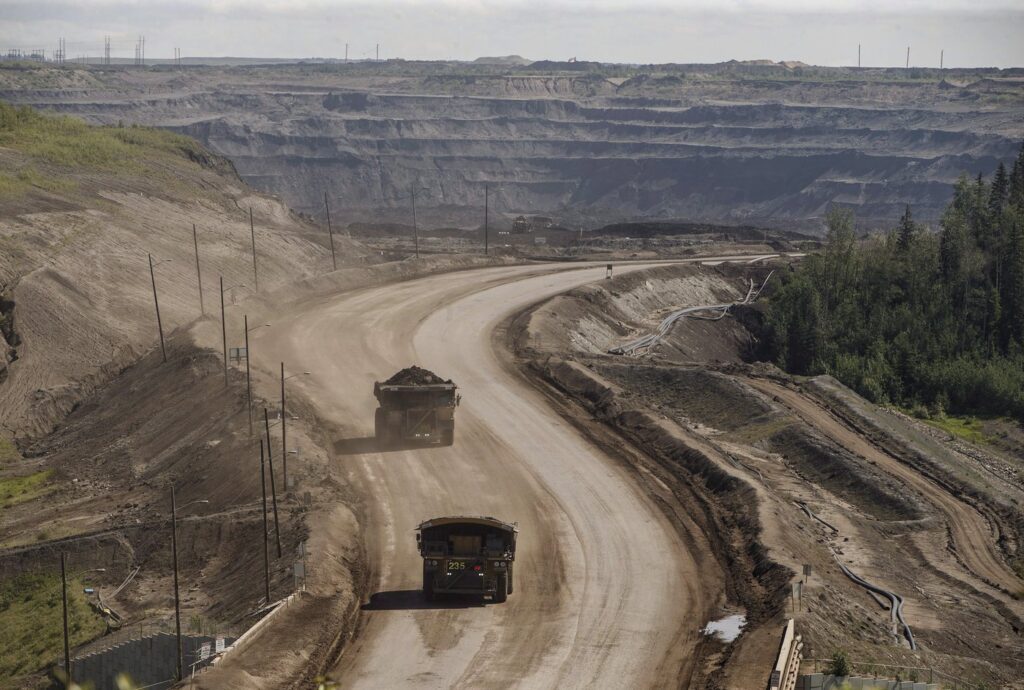
A heavy hauler trucks transports material from Suncor’s North Steepbank Mine in the oilsands in Fort McMurray Alta, on Monday June 13, 2017. Oilsands companies are exploring the possibility of deploying small modular nuclear reactors to create the heat needed in oilsands mining. THE CANADIAN PRESS/Jason Franson
CALGARY — The pressing global need to slash emissions in the face of a growing climate crisis is driving renewed interest in nuclear power — and few places more so than in Canada’s oilsands.
While the idea of using nuclear power to replace the fossil fuels burned in oilsands production has been bandied about for years, some experts say the reality could be just a decade or so away. On paper, at least, there is more potential to deploy small modular reactor (SMR) technology in the oilsands region of Alberta than anywhere else in the country.
“Without a doubt the oilsands is the biggest market for small modular reactors in Canada,” said John Gorman, president and chief executive of the Canadian Nuclear Association. “It’s something that some companies are very actively looking at.”
Small modular reactors are a type of nuclear design that is far smaller than a traditional nuclear reactor. Generating between 10 and 300 MW of energy, SMRs are fully scalable and are designed to be built economically in factory conditions, rather than on site like a large-scale conventional reactor.
While SMRs are not yet commercially available, the technology is getting close. The International Atomic Energy Agency estimates that nearly 100 SMRs could be operating around the world by 2030. In Canada, four provinces — New Brunswick, Ontario, Saskatchewan and Alberta — have agreed to collaborate on the advancement of SMRs as a clean energy option, and Canadian researchers are working on new materials and designs that could make SMRs practical in a large range of new uses.
Proponents say SMRs could potentially be used not only to provide clean electricity to smaller electricity grids, like those in rural areas, but also to provide heat for natural resource industries. In the oilsands, operators use massive amounts of high-temperature heat to produce the steam needed to extract bitumen from sand — and they get that heat by burning natural gas.
In total, the oil and gas industry is responsible for 30 per cent of Canada’s natural gas consumption, which means confronting the industry’s fossil fuel usage will be key if Canada is to meet its climate commitments.
The oilsands industry itself — through an organization called Pathways Alliance, which is made up of Canadian Natural Resources Ltd., Cenovus Energy Inc., ConocoPhillips Canada, Imperial Oil Ltd., MEG Energy Corp. and Suncor Energy Inc. — has committed to reducing greenhouse gas emissions from oilsands production by 22 million tonnes annually by 2030, and reaching a goal of net-zero emissions by 2050.
To help get there, the Pathways Alliance has proposed a major carbon capture and storage transportation line that would capture CO2 from oilsands facilities and transport it to a storage facility near Cold Lake, Alta. That project alone could deliver about 10 million tonnes of emissions reductions per year and could be up and running by the end of the decade.
But Pathways has also formed a committee to formally explore nuclear as an alternative to natural gas in oilsands production.
“Absolutely, we are looking at SMRs as a low or no-emission source of the high temperature heat we need,” said Martha Hall Findlay, chief climate officer for Suncor Energy Inc. “But it has to be economically viable. It has to make sense.”
Findlay said the industry will need clarity around what level of government financial support, if any, will be available for SMRs. There are also questions around the regulatory process, given the energy sector’s frustrating experience in recent years getting large-scale projects approved.
“It’s Canada — it takes a really long time to build anything,” she said. “But if we want to see implementation by 2030, or into the early 2030s, we have to be doing this stuff now. We have to be looking at it now.”
Dan Wicklum, president and CEO of non-profit advisory group The Transition Accelerator and the former CEO of the Canadian Oilsands Innovation Alliance, said the energy industry has formally evaluated the nuclear opportunity in the past and discarded it, largely because of cost.
But he said the industry’s new target of net-zero emissions “changes everything.”
“We can no longer just do the things we were going to do to reduce emissions. Optionality has fallen off the table for us,” Wicklum said. “In an emissions elimination paradigm, there’s no question that nuclear is being taken very seriously.”
However, Wicklum added that for any large-scale emissions reductions projects to get off the ground, governments and industry will have to come to an agreement about whose responsibility it is to pay for them.
“Industry is looking to the federal government to say, ‘make it worth our while’, he said. “They want more taxpayer dollars. They’ve essentially said there’s not enough public support right now for them to act. And because of that, I think, the feasibility of SMRs — as well as carbon capture and storage, and so on — is completely in question.”
This report by The Canadian Press was first published July 17, 2022.
Companies in this story: (TSX:TKTK)
Amanda Stephenson, The Canadian Press
- 0100 Turnbull Project Manager0100 Turnbull Project Manager
- 0099 Mryglod Steel 1080p0099 Mryglod Steel 1080p
- 0097 Eagle Sky Ventures LTD0097 Eagle Sky Ventures LTD
- 0095 Fast Trucking nearly 70 years good at it0095 Fast Trucking nearly 70 years good at it
- 0053 Kingston Midstream Westspur Alameda Click Before You Dig0053 Kingston Midstream Westspur Alameda Click Before You Dig
- 0092 Turnbull projects big and small0092 Turnbull projects big and small
- 0046 City of Estevan This is Estevan Teaser0046 City of Estevan This is Estevan Teaser
- 0087 Lori Carr Coal Expansion0087 Lori Carr Coal Expansion
- 0077 Caprice Resources Stand Up For Free Speech0077 Caprice Resources Stand Up For Free Speech
- 0076 Latus only0076 Latus only
- 0061 SIMSA 2024 For Sask Buy Sask0061 SIMSA 2024 For Sask Buy Sask
- 0055 Smart Power Be Smart with your Power office0055 Smart Power Be Smart with your Power office
- 0051 JML Hiring Pumpjack assembly0051 JML Hiring Pumpjack assembly
- 0049 Scotsburn Dental soft guitar0049 Scotsburn Dental soft guitar
- 0041 DEEP Since 2018 now we are going to build0041 DEEP Since 2018 now we are going to build
- 0032 IWS Summer hiring rock trailer music
- 0022 Grimes winter hiring
- 0021 OSY Rentals S8 Promo
- 0018 IWS Hiring Royal Summer
- 0013 Panther Drilling PO ad 03 top drive rigs
- 0006 JK Junior
- 0002 gilliss casing services0002 gilliss casing services
- 9002 Pipeline Online 30 sec EBEX9002 Pipeline Online 30 sec EBEX
- 9001
